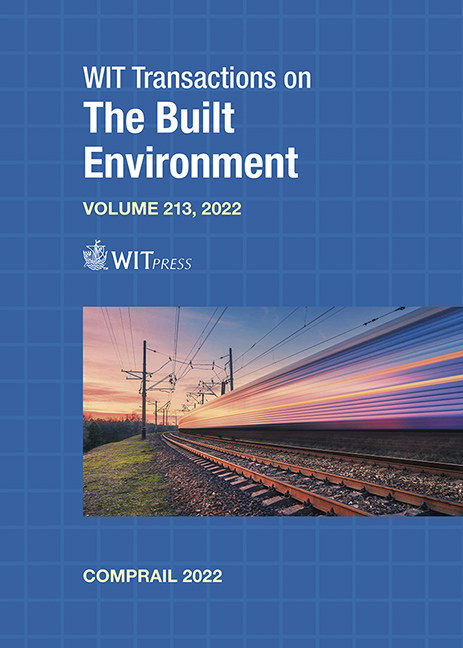ARTICULATED TRAIN OF DEEP WELL CARS FOR HIGH-SPEED CONTAINER TRANSPORT
Price
Free (open access)
Transaction
Volume
213
Pages
14
Page Range
121 - 134
Published
2022
Paper DOI
10.2495/CR220111
Copyright
Author(s)
FRIEDER HAFERKORN
Abstract
A literature search on the length, mass and speed of passenger and freight trains revealed a close connection; particularly high speeds seem to be allowed only trains whose mass is distributed over a correspondingly large length. The product of mass per length (t/m) and speed (m/s) appears in the dimension (t/s) to represent a kind of stress or footprint for the infrastructure of the tracks and bridges. Resonances caused by air flow around the successive vehicles within the train at the same distance can be avoided by the surface design. Resonances caused by wheel–rail vibrations can be damped by unsymmetric chassis such as those under the Talgo and AGV. High board walls prevent containers from detaching from the train due to vibrations. Derailments due to speed that is too high for the track geometry (e.g. track arches that are too narrow, transition arches that are too short) can at least be partially prevented by particularly large wheelbases, semi-permanent couplings between bogies and lateral buffers. In this way, the vehicle frames would be connected by a separable Jacobs bogie, which would transmit rolling torques along the train and prevent individual axles from climbing up. Unfortunately, despite all the safety systems, there are still collisions between trains. The proposed container train is very long for its mass, with only one high-cube container 40 ft per wagon and with a large wheelbase. This length can act like a built-in brake bumper in the event of a collision. In the event of a collision, the container load is protected by shortening the train as necessary. The development of the new high-speed container train is to be supported with data from our own simulations and measurements as well as from previous literature.
Keywords
mass per length, speed, stress for tracks and bridges, footprint, vibration resonances, asymmetric chassis, derailments, detachable Jacobs bogies, simulations, measurements





